Visual discrimination skill is the most essential skill needed in kindergarten. Visual discrimination skills are necessary for learning to read and write. Here, we discuss about visual discrimination skills, their importance, and different ways to develop them.
What are Visual discrimination skills?
Visual discrimination skill is the ability to determine the slight differences between similar things.
Our visual discrimination skills allow us to see the differences in size and texture. You are reading this because you can discriminate between letters and words. In simple words, it is the most important skill one needs.
The importance of visual discrimination skills
As you read earlier, you can read because of your Visual discrimination skill. Likewise, for a kid to learn to read and write, he should have strong visual discrimination skills. Then only they can distinguish letters and words.
For example, the letter a and d.
In writing, the difference is the length of the bar, if it is small then it’s a, and if it is tall it’s d.
i / j They look similar except for the curve on the lower side.
i / l here, the difference is the length and upper notch otherwise, it’s all similar.
Hence to recognize the letters, kids need to have strong visual discrimination skills.
Not only with letters but also with numbers the problem arises.
For new learners, they face difficulties with
- 1/ 7
- 6/ 9
- 3/ 8
At starting they struggle with these numbers. To develop a strong understanding of math, kids need good visual discrimination skills.
In short, in the learning process, it is needed everywhere. So we can’t avoid seeing its importance.
Ways to develop visual discrimination skills.
Now we are well aware of its importance. Some kids might have some issues with their visual discrimination skills, hence it’s necessary to improve their visual discrimination skills. There are many activities to improve the skills,
Let’s discuss some of the activities here.
Sorting
It is the best method to start. In This activity, ask the kid to sort one particular thing from many things according to size, color, or material.
( Examples:- sort cube blocks by color, sort same size
beads by color, sort wooden blocks by size, etc.)
Sorting with two conditions
It is the next level activity of the previous one. Here asked the kid to sort things with two conditions, like sorting same-sized cube blocks with red color only.
Puzzles
All puzzles are excellent tools for developing Visual discrimination skills. Always Start with simple puzzles. The puzzle should be age-appropriate and slowly move into challenging puzzles.
Matching games
Matches are another simple method. In this method, kids need to find out; matching pictures from many pictures.
Memory-matching games are also helpful. In this, the kid has only one look at the picture and remembers that find the matching picture.
Find the difference
For this two like pictures with slight differences are selected. Asked to find the differences in each picture. This method enables the children to recognize slight differences.
There are many, other methods available for developing visual discrimination skills, but we have only discussed a few methods.
Studies show that visual discrimination task shows, long-term improvement after getting good sleep.
Kindergarten classrooms are the best place to develop visual discrimination skills. The struggling kids in reading may be because of poor discrimination skills. Teachers and parents should give more priority to developing visual discrimination skills.


